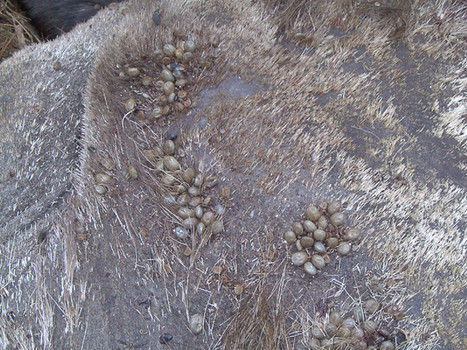
© Wikimedia Commons
, this is a term that is not going away anytime soon as moose are disappearing at an alarming rate across North America. This moose-die off is seen in several northern states where
ticks are prevalent and according to the
N.Y. Times on Oct. 14, moose have been found with over 100,000 ticks on them.
According to the
Northern Wild website, moose are testing positive for
Lyme disease.While climate change is considered a variable in the moose-die off, it is also a factor in the amount of ticks you will find during any given year. Ticks thrive when the weather is warmer.
The winter tick is one of several types of ticks found on animals in the wild, and according to the website,
Moose in Minnesota, this state is one of the states seeing the moose die-off, the moose population are visibly suffering from the ticks.
This is seen with moose that are missing massive spots of fur, as they have tried to remove the ticks from their bodies by rubbing up against trees. While a few ticks sucking the blood of a moose doesn't lead to much blood loss, but a hundred thousand ticks sucking blood can leave the moose with substantial blood loss.
The winter tick, found on moose, take their final blood meal in the spring, a time when the moose are at their weakest from a winter of very little food. According to
Lymedisease.org, a moose calf can lose their entire blood supply from ticks, killing them.
Lymedisease.org reports researchers blaming climate change for the population explosion in ticks. This is because ticks live longer when it is warmer and "reproduce in greater numbers if there's less snow on the ground by spring."
The battle between moose and tick is seen on the moose called "ghost moose," where large patches of white skin are seen because the ticks have ravished their bodies to the point that they are constantly rubbing up against trees trying to rid themselves of the parasite.
The winter tick is the species causing the most problem for moose in North America and this could very well be the origin of the moose die-off. In the fall, winter tick larva climb vegetation until they reach a height, which is about chest level of the moose. The larva stay there waiting for a host to brush by and carry them away. Up to 300,000 larva can jump on one moose.
While there are other hosts in the great outdoors, such as deer, moose seem to be a magnet for the winter tick, according to the Moose in Minnesota website.
Anyone who owns a dog in the northern part of the U.S. knows the danger of ticks to their domestic animals. Ticks are causing three strains of Lyme disease in dogs today and it is taking massive amounts of potent antibiotics to rid the dogs of the Lyme strains.
According to the Northern Wilds website, moose are testing positive for Lyme disease, but the symptoms associated with Lyme are not seen in the moose. The uncertainty around the moose die-off causes indicates the need for more research and a grant of $1 million plus has been allocated for the state of Minnesota to equip moose with monitoring and GPA equipment.
This equipment will give the location of a tagged moose every 15 minutes. When the monitoring equipment indicates that the moose's heart has stopped beating, wildlife staff will retrieve the body to study what the moose died from. Because moose are loners they are not easy to find in the wild and usual when a moose carcass is retrieved, it has been dead for a while.
With this new technology, researchers will be able to study the moose right after it meets its demise, hopefully this will give some indication in the cause of the moose die-off.
Reader Comments
to our Newsletter